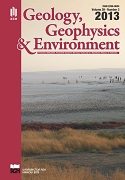Land subsidence caused by solution mining in the Mogilno salt dome
Main Article Content
Keywords
salt domes, land subsidence, salt caverns, twin-centre trough
Abstract
Occurrence of land surface subsidence is a result of rock salt extraction. The process is observed by geodetic measurements. On the Palędzie I salt mining field, such measurements are conducted every five years. The most recent series of measurements was carried out in 2009. The analysis of land levelling results indicated that a twin-centre subsidence is still being formed above the salt mining area. Its maximum load on the SW side of the salt dome exceeded −100 mm in 1986–2009. The second subsidence centre behind the NE edge pillar is 50% smaller than the first one. Along with the extraction moving up to shallower areas of the salt bed, the rate of land surface subsidence is increasing, with the decreasing perimeter of the depression. The indicators that describe the land surface subsidence – vertical displacement of benchmarks and the caverns volume – are presented on the function of time and a parameter, determining the distance from the measurement point to the exploitation field edges.
Downloads
Download data is not yet available.
References
Bailey R.W., 1929. Creep of steel under simple and compound stresses, and the use of high initial temperature in steam power plants. The transactions of the Tokyo Sectional Meeting, World Power Conference, Tokyo, October 29-November 7, 1929; vol. 3: Power for use in transportation, better efficiency in power production, 1089-1121.
Grzybowski Ł., Wilkosz P. & Flisiak D., 2008. Mechanical properties of rock salt from Mogilno salt dome. Gospodarka Surowcami Mineralnymi [Przegląd Solny], 24, 3/2, 141-157.
Kortas G. (red.), 2008. Ruch górotworu w rejonie wysadów solnych. Wydawnictwo Instytutu Gospodarki Surowcami Mineralnymi i Energią PAN, Kraków.
Kortas G., 2009. Singularities of the rock mass movement during the minning of salt domes. Conference Papers, Solution Mining Research Institute - Spring 2009, Kraków, 14 marca 2009.
Kortas G., Maj A., Flisiak D., Kortas Ł., Jagiełło W. & Kot P., 2011. Określenie optymalnych lokalizacji oraz geometrii komór eksploatacyjnych w południowo-wschodniej części złoża „Mogilno I". GeoConsulting Kraków, IKS Solino SA [unpublished].
Maj A., 2004. Obserwacja osiadań powierzchni nad wyrobiskami w wysadzie solnym na przykładzie kopalni Kłodawa. WUG: Bezpieczeństwo Pracy i Ochrona Środowiska w Górnictwie, 9, 25-28.
Norton F.H., 1929. The Creep of Steel at High Temperatures. McGraw-Hill, New York.
Szewczyk J., 2008. Kopalnia Soli „Wieliczka" - 80 lat obserwacji deformacji górniczych. Gospodarka Surowcami Mineralnymi [Przegląd Solny], 24, 3/2, 251-272.
Ślizowski J., 2006. Geomechaniczne podstawy projektowania komór magazynowych gazu ziemnego w złożach soli kamiennej. Studia, Rozprawy, Monografie - Polska Akademia Nauk. Instytut Gospodarki Surowcami Mineralnymi i Energią, 137, Wyd. IGSMiE PAN, Kraków.
Tadych I., Drogowski I., Grzybowski Ł., Kleczar M., Enghardt J. & Bornemann O., 2010. Optymalizacja procesu eksploatacji soli kamiennej w oparciu o geologiczną interpretację pomiarów georadarem złóż soli kamiennej „Góra" i „Mogilno I". XV Międzynarodowe Sympozjum Solne Quo Vadis Sal, Swieradów-Zdrój 21-22 października 2010 r., Polskie Stowarzyszenie Górnictwa Solnego, 62-64.
Grzybowski Ł., Wilkosz P. & Flisiak D., 2008. Mechanical properties of rock salt from Mogilno salt dome. Gospodarka Surowcami Mineralnymi [Przegląd Solny], 24, 3/2, 141-157.
Kortas G. (red.), 2008. Ruch górotworu w rejonie wysadów solnych. Wydawnictwo Instytutu Gospodarki Surowcami Mineralnymi i Energią PAN, Kraków.
Kortas G., 2009. Singularities of the rock mass movement during the minning of salt domes. Conference Papers, Solution Mining Research Institute - Spring 2009, Kraków, 14 marca 2009.
Kortas G., Maj A., Flisiak D., Kortas Ł., Jagiełło W. & Kot P., 2011. Określenie optymalnych lokalizacji oraz geometrii komór eksploatacyjnych w południowo-wschodniej części złoża „Mogilno I". GeoConsulting Kraków, IKS Solino SA [unpublished].
Maj A., 2004. Obserwacja osiadań powierzchni nad wyrobiskami w wysadzie solnym na przykładzie kopalni Kłodawa. WUG: Bezpieczeństwo Pracy i Ochrona Środowiska w Górnictwie, 9, 25-28.
Norton F.H., 1929. The Creep of Steel at High Temperatures. McGraw-Hill, New York.
Szewczyk J., 2008. Kopalnia Soli „Wieliczka" - 80 lat obserwacji deformacji górniczych. Gospodarka Surowcami Mineralnymi [Przegląd Solny], 24, 3/2, 251-272.
Ślizowski J., 2006. Geomechaniczne podstawy projektowania komór magazynowych gazu ziemnego w złożach soli kamiennej. Studia, Rozprawy, Monografie - Polska Akademia Nauk. Instytut Gospodarki Surowcami Mineralnymi i Energią, 137, Wyd. IGSMiE PAN, Kraków.
Tadych I., Drogowski I., Grzybowski Ł., Kleczar M., Enghardt J. & Bornemann O., 2010. Optymalizacja procesu eksploatacji soli kamiennej w oparciu o geologiczną interpretację pomiarów georadarem złóż soli kamiennej „Góra" i „Mogilno I". XV Międzynarodowe Sympozjum Solne Quo Vadis Sal, Swieradów-Zdrój 21-22 października 2010 r., Polskie Stowarzyszenie Górnictwa Solnego, 62-64.


